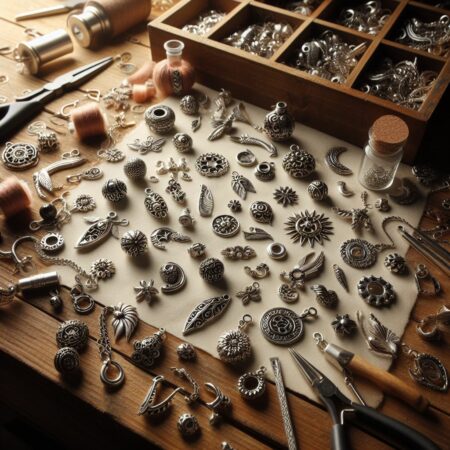Mastering beading wires is essential if you want to work with various bead types, from beautiful gold-filled beads to sterling silver beads. Expert beadwork begins with knowing how beads are sized and measured. Step two is understanding the popular types of beads. The third step is shifting your focus to beading wires and beading threads.
Exploring Beading Wires
What Wire Do You Use for Beading?
All strung beaded jewelry starts with stringing materials. Stringing materials include silk, steel, and a variety of other materials. Flexible beading wire, leather string, silk thread, elastic, nylon, and rubber are popular materials.
To suit a variety of bead hole sizes, most stringing materials come in several diameters. This type provides us with a lot of creativity in constructing bracelets and necklaces.
We recommend trying stainless steel beading wire for most projects.
Flexible beading wire is a stainless-steel beading wire with a nylon coating. It is currently one of the most often utilized stringing materials. Crimp beads are used to attach clasps to this stringing material quickly and firmly. The diameter of the flexible beading wire determines the size and type of crimp beads used.
SoftFlex and Beadalon are two popular kinds of flexible beading wire. Both companies provide the highest-quality options in a wide range of diameters, flexibility, and colors. In addition, flexible beading wire is available in various hues, including black, white, and different seasonal fashion colors, and the standard silver, gold, and base metal colors.
It’s advisable to use the thickest wire to fit comfortably through the beads for most stringing jobs. In addition, different widths of flexible beading wire are advised for varying sizes and weights of beads.
The likelihood of the wire kinking after the beads are strung is reduced by choosing a flexible beading wire with a higher number of steel strands. Also, restring your creation on a narrower diameter flexible beading wire or non-stretch nylon cord if it won’t relax and hang well after being strung.
Exploring Beading Threads and Cords
What Thread is Best Used for Beading?
Natural Stringing Materials for Beadwork
While it’s true that flexible beading wire is quite famous for stringing beads, natural stringing materials are better for some forms of jewelry or specific beads. The natural properties of these stringing materials provide jewelry strung on them with an organic feel. Leather, cotton, linen, and silk are popular raw materials for cords.
- Leather cords are a popular choice for beadwork. The tanned hide is colored and shaped into spherical cords with diameters ranging from .05 to 5 millimeters.
- Cowhide leather cording of the highest quality is created in Greece. Leather cording from India and China is of lower quality and less supple. To connect a clasp, coil crimps are bonded and crimped to the ends of the leather cording.
- Suede is made from the bottom of a cow or deer hide with the hard skin covering taken away, leaving a napped surface. Suede is colored before being cut into flat cords. Suede cording is softer and less durable than leather because it lacks a robust outer covering. Suede is most associated with big beads with giant holes. To attach a clasp to the suede cord, fold-over crimps are utilized.
- Waxed cotton is a durable, strong, tightly woven cotton rope that has been lightly waxed. Waxed cotton is available in various sizes and is ideal for stringing beads with holes that match the cord’s diameter. To attach a clasp to a waxed cotton cord, use foil crimps or fold-over crimps.
- Waxed linen is a thin, tightly woven linen cord with a wax finish for added durability. Waxed linen is ideal for micro macramé and stringing beads with smaller holes since it comes in various hues. When attaching a clasp, bead points can be placed to the ends of waxed linen.
- Hemp is a durable fiber that is also environmentally beneficial. Hemp is most associated with macramé, but it can also be used to string larger organic beads. Hemp is available in various thicknesses and dyed in a wide range of colors. To attach a clasp to hemp, both foil crimps and fold-over crimps can be utilized.
- Silk is usually used to knot beads together, but it can also string tiny, light beads. It’s available in various sizes and diameters to fit most types of beads and bead holes.
- Carded silk is one of the most common varieties of silk cord. The beading needle is already linked to this twisted silk-wrapped on a card. Carded silk is available in multiple diameters starting from 0.30 mm. Silk spools are also available and are typically used for lengthier knotting tasks. Spooled silk is available in diameters ranging from 00 (0.012 mm) to FFF (0.419 mm). When attaching a clasp, bead points can be attached to the ends of the silk cord.
Synthetic Stringing Materials for Beadwork
Synthetic stringing materials are also a fine choice for many crafting projects. Artificial cords, elastic cords, and ribbons are popular among individuals who want vegan options for designs that require flexibility or for any use where a natural material isn’t appropriate. For durability, jewelry that will never be taken off or worn in the water frequently should be strung on a manufactured material.
- Genya is a synthetic leather stringing material that comes in a spherical shape. It’s ideal for people who prefer a vegan stringing material or for jewelry that will be regularly exposed to wetness. The most standard diameters are 1 and 2 millimeters, which can accommodate beads with holes larger than 1 millimeter. A clasp is attached to Genya using coil crimps.
- Elastic cording is perfect for creating stretchable jewelry. Bracelets and anklets are strung with a clear, circular form of stretch cord. It’s available in three thicknesses and doesn’t require a beading needle. Instead, a square knot and a drop of solid adhesive are needed to finish a creation bound with elastic cording.
Bracelets and anklets can be strung using the multistrand flat stretch cord, but beads with a huge eye or twisted wire needle must be strung. A square knot and some super glue or clear nail paint can also be used to finish the flat stretch cable.
Stringing heavier beads is easier with a cotton-covered elastic cord, commonly used in garments. The cable comprises an opaque flexible core and a densely woven cotton sheath. This sort of elastic is available in a variety of colors.
Satin, grosgrain, organza, and velvet are just a few fabrics and weaves available. Simple flat chokers and bracelets are particularly well-suited to this flat stringing material. A clasp is attached to a piece of ribbon jewelry using special ribbon crimps. Glue and crimp bead tips or fold-over crimps when adding a clasp to a thin ribbon.
- Satin cord is a circular, synthetic silk cording available in various hues. It is available in diameters of 1 and 2 millimeters and is used for simple stringing applications. One-millimeter satin cord is known as “mouse tail,” whereas a two-millimeter satin cord is known as “rat tail.” Coil crimps or fold-over crimps are employed to attach a clasp to a satin cord.
- Nylon cording comes in a variety of colors and styles. The first is a bonded, no-stretch nylon thread commonly used for stringing and knotting. The second is a 3-ply twisted multifilament nylon cording used for micro macrame, kumihimo, crochet, and stringing projects. Nylon cording comes in three different weights: fine, medium, and heavy. When adding a clasp to nylon cording, bead tips are often used. Off-loom weaving, illusion necklaces, and bead stringing can all be done with a transparent nylon cord. This cord is available in various diameters to accommodate a variety of bead hole sizes. In addition, knots and crimps can be done with a transparent nylon cord. Crimp beads are utilized to attach a clasp to a transparent nylon cord.
- Rubber cords are a water-resistant stringing material available in hollow and solid round cording. Rubber cording is commonly known in diameters of 1 millimeter, 2 millimeters, and 3 millimeters. To attach a clasp to the rubber cording, use coil crimps, fold-over crimps, or glue-on ends.






